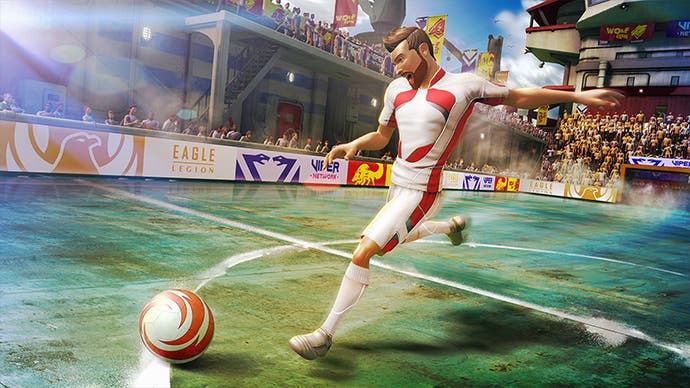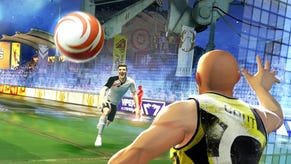Kinect Sports Rivals review
Warm down.
Your first act in Kinect Sports Rivals is to kneel in front of the Kinect 2.0, Microsoft's fat, sinister slab of a camera - but it's no act of reverence. It's been eight years since Nintendo released Wii Sports, the game that ushered in a new way to play video games using grand swipes and waggles rather than plain button presses. Most players now view the once-exciting promise of motion control with apathy. Wii Sports' imitators broadly failed to find new and improved ways to explore the technology and following 2009's Wii Sports Resort, even Nintendo appears to have moved on from the game that was instrumental in selling more than 100 million Wii systems (judging by its half-hearted promotion of the Wii U remake, Wii Sports Club).
Rare has an unusually challenging task with Kinect Sports Rivals, then. It must reignite interest in motion control games in general and, specifically, it must convince sceptical Xbox One owners (and potential owners) that Kinect 2.0 has relevance in interactive entertainment - even as the return of virtual reality pushes it to the periphery.
Perhaps for this reason, before you're free to bat balls, climb walls or ride waves, Rare first asks you to give yourself afresh to the form - or at least to offer it your likeness. As you sit or kneel, the camera maps the contours of your face. It notices your skin tone, the sweep, flop or absence of your hair and assimilates all of the other features (glasses, facial hair) that distinguish you from the next player. The game chews the data and, finally, spits out a cartoon approximation of your likeness to represent you in the game. It's a caricature, obviously pieced together from a palette of pre-existing options, but the results are still impressive; it's a good trick that quickly establishes the distance in fidelity between Kinect 2.0 and its predecessor. This is technology that knows when you smile and when you frown, when your hand is open and when it is clenched.

Good job too, as it's a clenched fist that fires Wave Racing, the first of the game's six sporting events to be unlocked for play. It's a new event for the series and its promotion to pole position is understandable; it's one of the best of the set and reveals a finesse of control that would only be possible with the updated hardware. Rare draws inspiration for the jet ski event from its former partner Nintendo's Wave Race series; in both games, you race around a brightly lit, high-contrast harbour while jostling with opponents for the lead.
Regardless of whether you're stood or seated, Kinect tracks whether your right hand is open or clenched and adjusts your acceleration accordingly. To turn the craft you move one fist forward and the other backward as if clutching the handlebar on a jet ski. In my experience it worked flawlessly, every time. While you never have quite the same degree of precision offered by a simple control stick, the full-body gimmick of throwing your weight into turns, lifting your hands into the air while performing tricks off waves or ramps and stomping your foot to trigger your chosen special move remains surprisingly enjoyable.
Rock Climbing, the second unlocked sport, is similarly successful. Here you must scale a series of giant structures from cliff walls to upturned ocean liners in a race to the summit. You search for handholds as you move your arms and grasp your hands, hauling yourself onwards. You can jump into the air to trigger an upwards leap - used either to clear a gap or to avoid a pursuing opponent, who will try to grab your ankle and throw you off the structure (you explode into a puff of pixels when you hit the ground). Bowling, arguably the strongest mini-game in Nintendo's original Wii Sports, also works well with Kinect 2.0. The game ably interprets fast and slow throws and it's possible to add topspin with a flick of the wrist.
These simple sporting interactions translate well from player to screen - something that cannot be said for Target Shooting. In this event, Rare attempts to revive the dormant light-gun shooter genre without the use of a peripheral. You aim a finger at the screen in a race against an AI opponent to shoot targets. Kinect cannot pick out a trigger finger, however. Instead, simply pointing your finger at a target sets off a shot after a brief pause. Moreover, your targeting reticule never sits quite in the line of sight from your finger, so you must constantly compensate for the inaccuracy. The result is an event that's significantly less enjoyable than 20-year-old light-gun games.

Football has been similarly simplified and, in the process, made somehow more fussy. Here you take turns with an AI-led team to pass the ball from your goalkeeper up the field towards your striker, who is then able to take a shot on goal. If the shot is saved, then control switches to the opposing team, who pass the ball towards your net. You must save their shot while playing as the goalkeeper. Kinect struggles to read the direction of the player's kicks and punts and, as the game enters a slow-motion phase when the ball approaches your striker, the natural rhythm of play is interrupted as you take to kicking in slow motion in order to execute a final shot on goal.
Similar problems arise in Tennis, where Kinect struggles to read the serving swipe of the arm, even if, once the ball is in play, lobs, volleys and topspin shots are mostly executed smoothly. The six sports vary in quality, then - with or without technical difficulties. As before, your experience may vary according to the size, shape and brightness of the room in which you play and the tiresome ritual of recalibrating the camera may or may not fix any issues you encounter.
Like Wii Sports Resort, Kinect Sports Rivals is set on an island: its contours and microclimates offer locales for each of the game's events. While there's less of a sense of place than Wuhu Island possessed (you cannot, for example, pilot an aircraft around Rare's nameless island, as you could in Nintendo's game), there is a far greater emphasis placed on narrative. A gruff cliché of a military sergeant teaches you how to play each of the six game types and, once each new sport is unlocked, you're introduced to the three dominant teams in the island league, who each petition for you to join their ranks with pantomime overstatement. As you complete story missions you gain 'fans' and, when you acquire the requisite number of fans, you unlock new outfits, equipment, special moves and stages.
More interesting than the AI opponents are rival Xbox Live players who are downloaded into your game and slotted into events and competitions. This is asynchronous multiplayer; you never compete with another player in real-time. Instead, you play against their avatars, whose proficiency is dictated by progress they have made in each individual sport within their own game. The system works well; it's even possible to send challenges to other players from the main island hub, taking turns with them to, for example, play rounds of bowling.
Many of Kinect Sports Rivals' problems are separate from Rare's robust work; they are more general issues that affect Kinect and all motion control games

Many of Kinect Sports Rivals' problems are separate from Rare's robust work; they are more general issues that affect Kinect and all motion control games. The cost of motion control - especially without the involvement of a Wii Remote or PlayStation Move - is an obfuscation of input. Where once the console knew in no uncertain terms what you wanted to do and when, with Kinect it must attempt to interpret your intentions, something that can be affected by sunlight, space and even the colour of your clothes.
Why introduce these imperfections? Kinect's proponents argue that the elimination of a controller removes a physical barrier between player and game and, as a result, immersion is increased; the cost is worthwhile. But there is something existentially weird about being asked by a game to pretend to straddle a jet ski in front of a television screen. Played with friends, there is humour to the mime. But played alone or in earnest, as this game urges, you cannot help but feel ridiculous. The stark reality of the make-believe is fully revealed.
Kinect Sports Rivals is a well-constructed game with an enjoyable structure and smartly integrated multiplayer. But it's already looking dated as it continues to struggle against the limitations of its chosen interface. For all the extra power of Kinect 2.0, and the surrounding artifice of online competition, at its best the game only equals the highs of older, more familiar games - games whose players and makers have moved on.

















